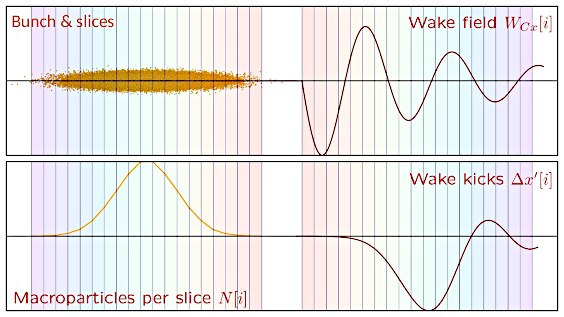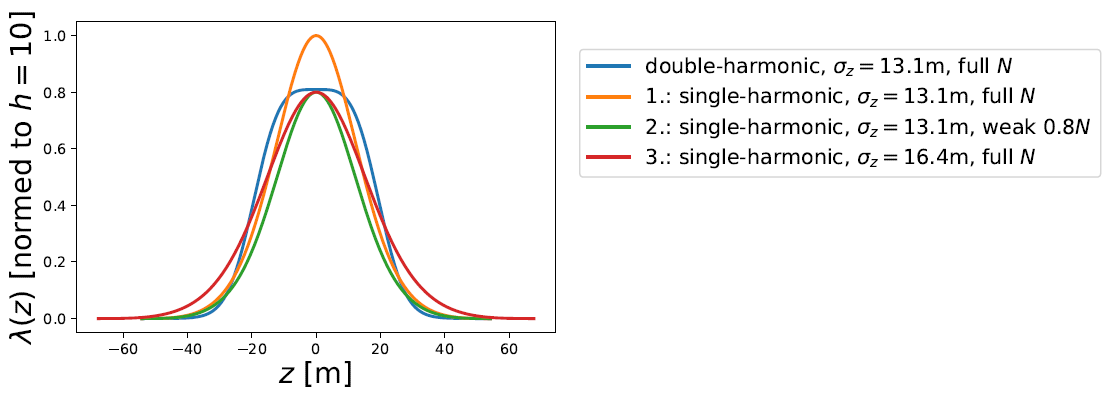Simulation of Intense Beams in Synchrotrons¶
... a story of resonances and instabilities.¶
a notebook talk by Adrian Oeftiger $\nearrow$¶
in the GSI Accelerator Seminar on 3 September 2020 $\nearrow$. See also rendered talk on github $\nearrow$ and source in github repo $\nearrow$.
Goals of this talk¶
showcase new simulation suite for SIS18 and SIS100
no theory, rather hands-on experience
practical modelling examples with live simulations
give overview of applications
Abstract¶
This introduction on collective beam dynamics focuses on high-intensity effects in synchrotrons like SIS18 or SIS100. The charged particles in the beam interact (a.) with the beam self-fields they produce and (b.) with the induced currents in the vacuum pipe. This interaction leads to corresponding collective effects, such as "space charge" (self-field interaction) or "beam coupling impedance" (interaction with the surroundings). The beam can become resonantly excited or is even driven into exponential instabilities over many revolutions in the circular accelerator. These effects potentially limit the performance, they scale with the number of particles in the beam: their understanding (and mitigation) is crucial to safely operate synchrotrons like SIS100 at highest beam intensities.
We dive into the world of these collective effects in beam physics, exploring their mechanisms and how they can lead to beam loss. During the talk, we also look behind the scenes on how to numerically model such long-term effects, in particular employing high-performance techniques such as GPU computing.
How to run this notebook at GSI:¶
Connect to the GSI high-performance computing cluster virgo.hpc (with port forwarding), load the accelerator physics environment and run the jupyter notebook server:
$ ssh virgo.hpc -L 8888:localhost:8888
$ singularity exec --bind /cvmfs \
/cvmfs/vae.gsi.de/centos7/containers/user_container-develop.sif \
bash -l
Singularity> cd /cvmfs/aph.gsi.de/
Singularity> source modules.sh
Singularity> module load aph_all
Singularity> cd
Singularity> git clone https://github.com/aoeftiger/GSI-acc-seminar-09-2020
Singularity> cd GSI-acc-seminar-09-2020
Singularity> jupyter notebook --no-browser --port=8888
... and you're ready to open your local browser and type in localhost:8888, where you open this notebook.
How to run this notebook on your individual workstation:¶
Install PyHEADTAIL $\nearrow$, cpymad $\nearrow$, PySixTrack $\nearrow$ and SixTrackLib $\nearrow$ in your python3 environment and run this jupyter notebook.
Note: if you don't have openCL drivers installed, replace all device=... instructions in SixTrackLib within this notebook by device=None to run on a normal single CPU thread.
Structure¶
PyHEADTAIL: collective beam dynamics- Wakefields & 1st Order Coherent Instabilities
SixTrackLib: symplectic non-linear 6D tracking- Space Charge & Resonances and 2nd Order Coherent Instabilities
Beam dynamics¶
3D particle motion $\leadsto$ 6 phase space coordinates: $$\mathbb{X}=(\underbrace{x, x'\vphantom{y'}}_{horizontal}, \underbrace{y, y'}_{vertical}, \underbrace{z, \delta\vphantom{y'}}_{longitudinal})$$
A beam $=$ state of $N$ macro-particles $=$ $6N$ values of phase space coordinates
Simulations:¶
- typically up to $\mathcal{O}(10^6)$ macro-particles
- accelerator elements to track through: up to $\mathcal{O}(1000)$
- simulations can last up to $\mathcal{O}(10^6)$ turns
- particle-to-particle interaction: binning, FFT, convolution, particle-in-cell, Poisson solvers
Requirements for simulation tools¶
- accurate: long-term evolution $\leadsto$ double precision
- fast: heavy number crunching $\leadsto$ high-performance computing (HPC)
(multi-core CPU, multi-nodes (MPI) or GPU parallelisation, in particular for collective effects) - flexible: iterative development of accelerator models with frequent updates $\leadsto$ python

The macro-particle simulation model¶
single-particle physics $\implies$ "tracking": particle motion due to external focusing (magnets and RF cavities)
multi-particle physics $\implies$ "collective effect kicks": direct and indirect particle-to-particle interaction
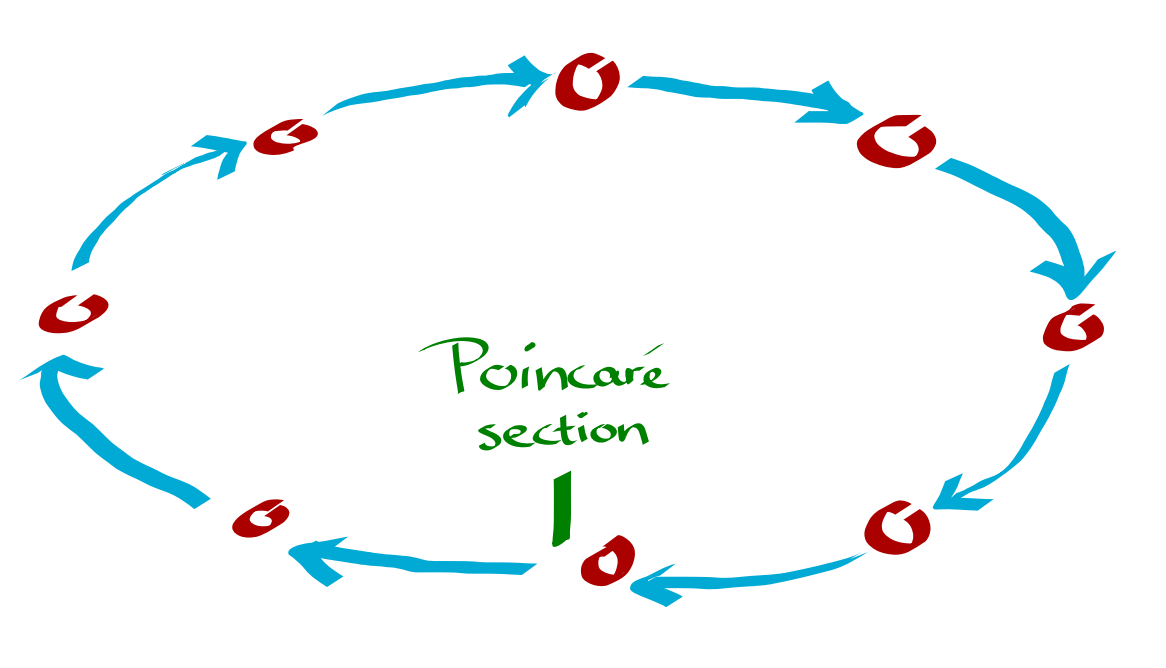 Tracking around the accelerator ring
Tracking around the accelerator ring
Many macro-particle codes...¶
... with (transverse) collective effects for synchrotrons, e.g.:
PATRIC(GSI)MICROMAP(GSI)IMPACT(Berkeley)Synergia(Fermilab)(Py)ORBIT(SNS)SIMPSONS(J-PARC)elegant(Argonne)MAD-X SC(CERN)HEADTAIL/PyHEADTAIL(CERN, GSI)- ...
1. PyHEADTAIL: collective beam dynamics¶
The PyHEADTAIL library¶
GPU-enabled, python based code for simulating collective beam dynamics in synchrotrons: github repo $\nearrow$
$\implies$ matrix-based transverse and non-linear longitudinal tracking
$\implies$ detailed models for collective effect kicks
 Kick example: wakefield from leading particles affects trailing particles
Kick example: wakefield from leading particles affects trailing particles
PyHEADTAIL on one slide¶
- origin:
CcodeHEADTAILby G. Rumolo (2000), 5 PR-STAB and 2 PRL papers - modernised
PyHEADTAILused for:- impedance-driven instabilities: head-tail modes, transverse mode coupling instability (TMCI), coupled-bunch instabilities, ...
- space charge
- electron cloud instabilities
- mitigation techniques: feedbacks, octupoles for Landau damping, multi-harmonic RF, ...
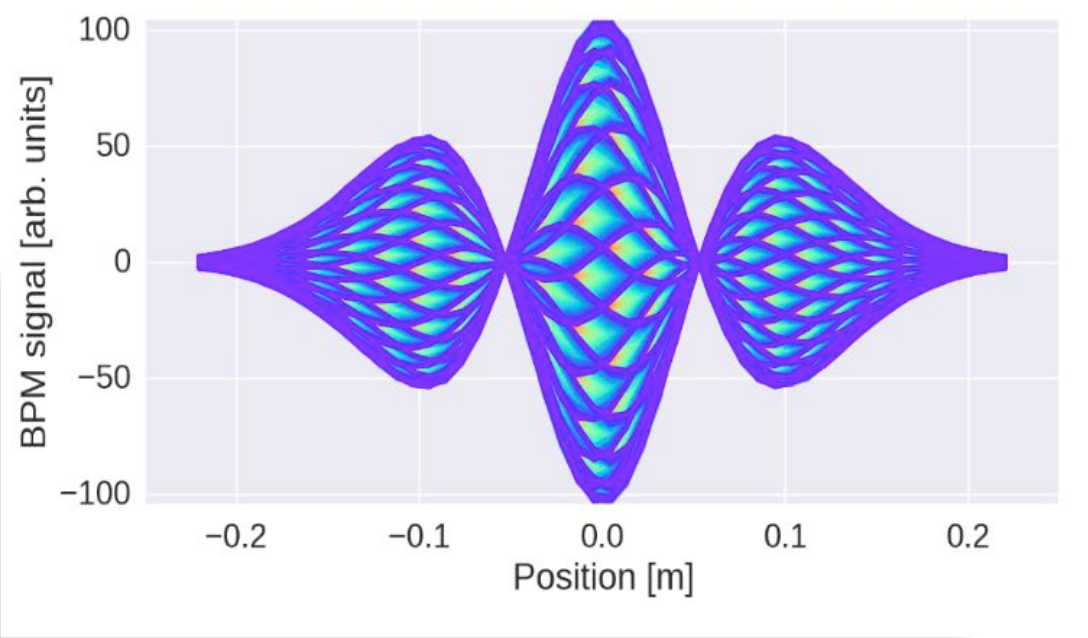
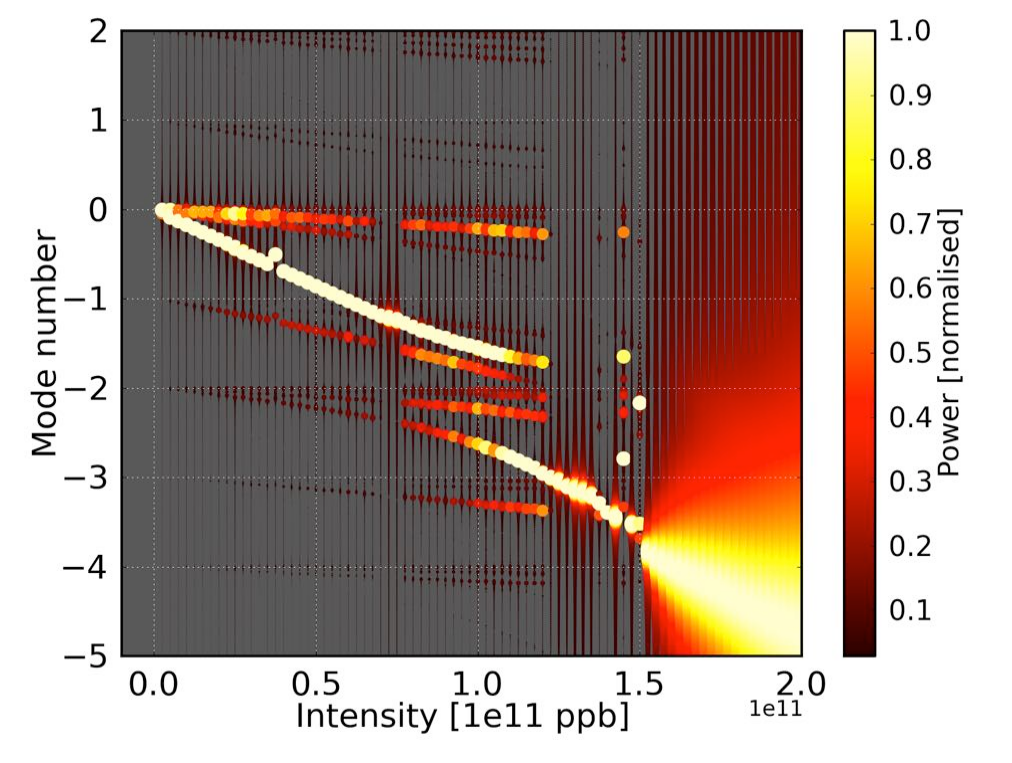


PyHEADTAIL modules¶
- wakefields:
- resistive wall
- broad-band resonator
- custom wake tables
- space charge
- selfconsistent PIC
- longitudinal, (slice-by-slice) transverse, 3D
- open boundary Green's function (FFT)
- open/rectangular boundary finite difference
- frozen / adaptive field maps
- selfconsistent PIC
- feedback (ideal and realistic [separate version])
- RF quadrupoles
- synchrotron radiation
- e-cloud pinch
- e-lens
Resources¶
- PyHEADTAIL playground $\nearrow$: interactive tutorials
- Overview of PyHEADTAIL $\nearrow$: Oeftiger, A. An Overview of PyHEADTAIL. CERN-ACC-NOTE-2019-0013.
- PyHEADTAIL + SixTrackLib on GPU $\nearrow$: interactive notebook talk
- SWAN beam dynamics gallery $\nearrow$: CERN platform to launch tutorials
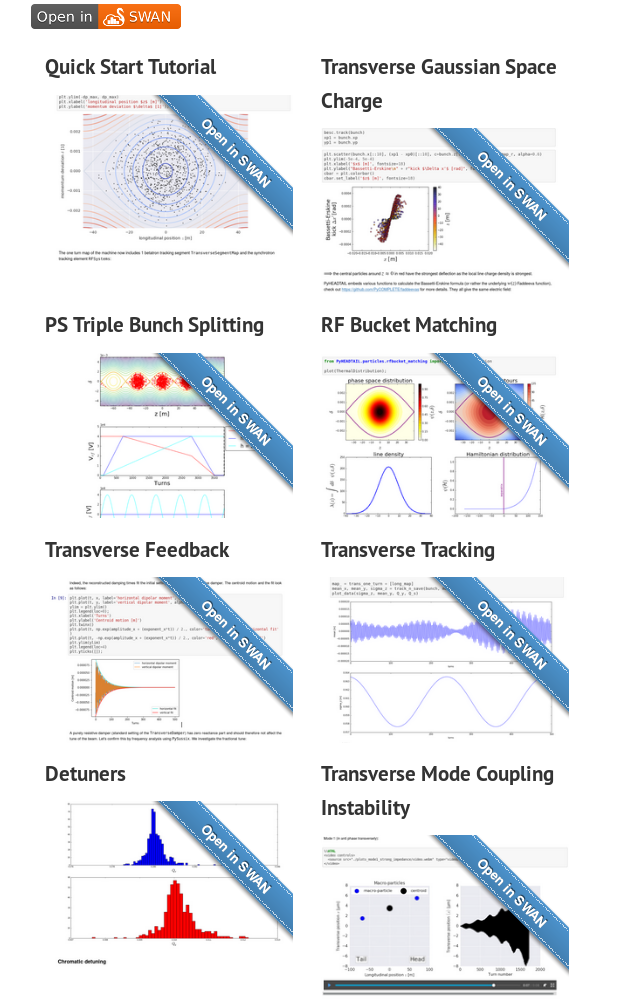
2. Wakefields & Dipole Moment Instabilities¶
Dipole wake fields (driving impedance)¶
Transverse kick on slice $i$ from previous slices due to wake $W_d$:
$$\Delta x'[i] \propto \sum\limits_{j=0}^i N[j] \quad \langle x \rangle [j] \quad W_d(z[i] - z[j])$$no synchrotron motion:
- kicks accumulate, linac-like beam breakup
with synchrotron motion: feedback loop
- chroma $Q'=0$:
- synchrotron sidebands separate $\rightarrow$ stable beam
- synchrotron sidebands couple $\rightarrow$ transverse mode coupling instability
- chroma $Q'\neq 0$: head-tail instability
- chroma $Q'=0$:
Simulating head-tail instability in SIS100¶
$\rightarrow$ use PyHEADTAIL to simulate head-tail instability due to resistive wall impedance of SIS100 vacuum tube:
# set up plotting etc
from imports import *
Importing PyHEADTAIL:
import PyHEADTAIL
PyHEADTAIL v1.14.1.28 (commit gc108ffeac6)
Setting up tracking around the SIS100 ring¶
Transverse tracking:
from PyHEADTAIL.trackers.transverse_tracking import TransverseMap
from PyHEADTAIL.trackers.detuners import Chromaticity
from pyheadtail_setup import transverse_map_kwargs, Q_x, Q_y
print ('chosen horizontal tune: {:.2f}, vertical tune: {:.2f}'.format(Q_x, Q_y))
chosen horizontal tune: 18.84, vertical tune: 18.73
Low, slightly positive chromaticity below transition $=$ strong growth rate of rigid bunch mode
transverse_map = TransverseMap(
detuners=[Chromaticity(
Qp_x=5, Qp_y=5)],
**transverse_map_kwargs,
)
Longitudinal tracking:
from PyHEADTAIL.trackers.longitudinal_tracking import RFSystems
from pyheadtail_setup import longitudinal_map_kwargs
longitudinal_map = RFSystems(**longitudinal_map_kwargs)
Setting up collective effect kick¶
Simulate wakefields in bunch via circular resistive wall model:
from PyHEADTAIL.impedances.wakes import WakeField, CircularResistiveWall
from PyHEADTAIL.particles.slicing import UniformBinSlicer
# responsible for binning the beam longitudinally:
slicer = UniformBinSlicer(n_slices=40, n_sigma_z=3)
resistive_wall_wake = CircularResistiveWall(
pipe_radius=0.03,
resistive_wall_length=longitudinal_map_kwargs['circumference'],
conductivity=1.4e6,
dt_min=None,
n_turns_wake=1,
)
wakefield = WakeField(slicer, resistive_wall_wake)
Assembling the map around the SIS100 ring:¶
pyht_ring_elements = list(transverse_map) + [longitudinal_map, wakefield]
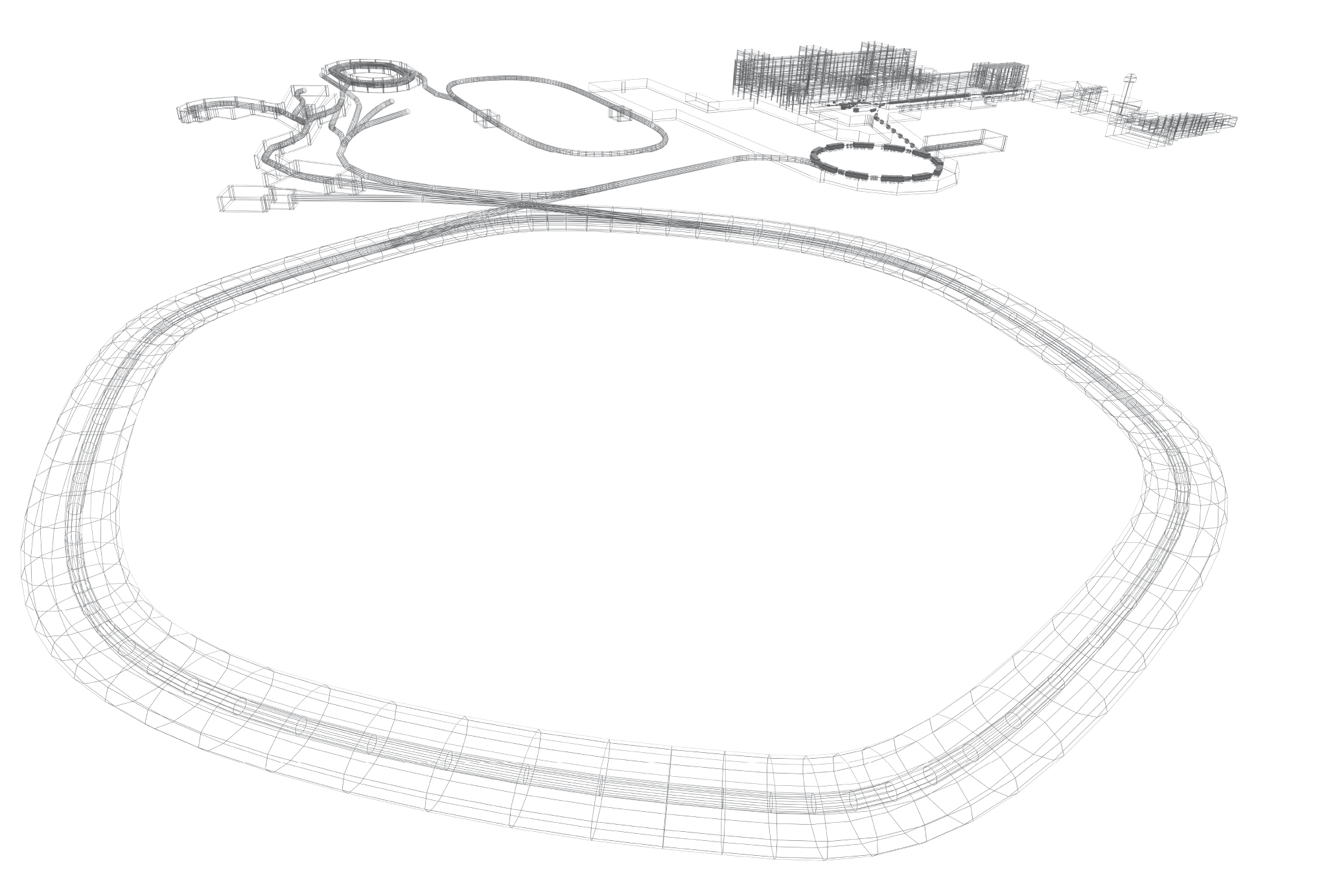
Initialising the particle bunch¶
from PyHEADTAIL.particles.generators import generate_Gaussian6DTwiss
from pyheadtail_setup import beam_kwargs
n_macroparticles = 2000
intensity = 6.25e10
np.random.seed(0)
pyht_beam = generate_Gaussian6DTwiss(
macroparticlenumber=n_macroparticles,
intensity=intensity,
**beam_kwargs,
**transverse_map.get_injection_optics(
for_particle_generation=True),
)
We'll give the bunch an initial kick:
pyht_beam.y += 0.1 * pyht_beam.sigma_y()
slices0 = pyht_beam.get_slices(slicer, statistics=['mean_y'])
resistive_wall_wake.dt_min = slices0.convert_to_time(slices0.slice_widths[0])
Let's go – simulating SIS100 in PyHEADTAIL:¶
n_turns = 10000
my = np.zeros(n_turns, dtype=float)
# loop over turns
for i in range(n_turns):
# loop over elements around ring
for element in pyht_ring_elements:
element.track(pyht_beam)
# record vertical bunch centroid amplitude
my[i] = pyht_beam.mean_y()
Outcome of our simulation?¶
plt.plot(my * 1e3)
plt.xlabel('Turns')
plt.ylabel(r'$\langle y \rangle$ [mm]')
plt.title('Vertical bunch centroid motion');
$\leadsto$ centre-of-mass of the bunch grows exponentially $\implies$ instability!
Let's fit the exponential growth rate:
growth_rate, _ = np.polyfit(np.arange(n_turns), np.log(my**2) / 2., 1)
print ('growth time: {:.0f} turns ~ {:.3f} sec'.format(
1 / growth_rate, 1083.6 / (0.567 * 3e8) / growth_rate))
growth time: 1963 turns ~ 0.013 sec
plt.plot(my * 1e3)
plt.plot(np.arange(n_turns),
max(abs(my[:10]))* 0.8 * 1e3 *
np.exp(growth_rate * np.arange(n_turns)),
ls='--')
plt.xlabel('Turns')
plt.ylabel(r'$\langle y \rangle$ [mm]')
plt.title('Vertical bunch centroid motion');
from imports import plot_intrabunch
plot_intrabunch(pyht_ring_elements, pyht_beam, slicer, slices0)
$\implies$ indeed a rigid bunch mode, no nodes!
Common mitigation strategies for head-tail instabilities¶
- change chromaticity: sextupole magnets
- Landau damping: octupole magnets
- linear coupling: skew quadrupole magnets
- active transverse feedback (damper)
Mitigation 1: Chromaticity¶
- higher-order modes $=$ lower growth rate
- for below (above) transition $\rightarrow$ go to negative (positive) chromaticity
- mode growth rates e.g. from Sacherer approach (1974)
 example CERN PS
example CERN PS taken from R. Cappi, Observation of high-order head-tail instabilities at the CERN-PS, CERN/PS 95-02
Mitigation 2: Octupoles¶
- detuning with transverse amplitude $=$ tune spread $\leadsto$ Landau damping
- dispersion relations to solve for stability diagrams
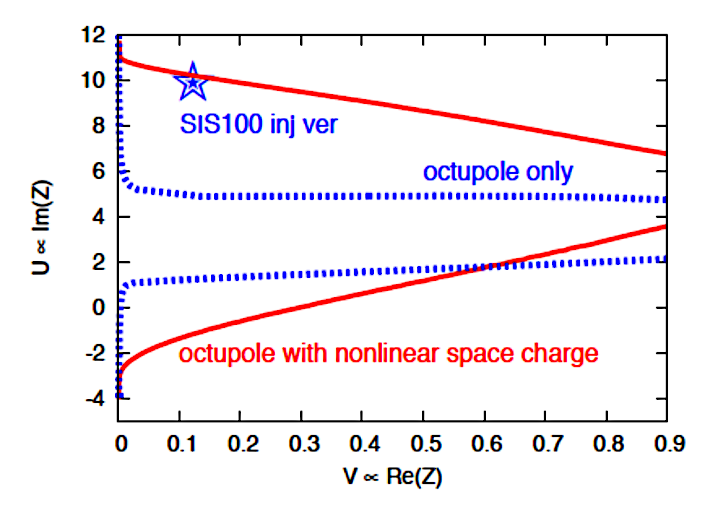 V. Kornilov on MAC20b or PRSTAB 11, 014201 (2008)
V. Kornilov on MAC20b or PRSTAB 11, 014201 (2008)
Mitigation 3: Coupling¶
- mix growth rates of transverse planes (e.g. CERN PS)
- "share" Landau damping
See e.g. Métral, E. Theory of coupled Landau damping. Part. Accel., 62 (1999) 259. $\nearrow$
Mitigation 4: Damper¶
Let's use the foreseen SIS100 damper with $100$ turns $\nearrow$ to stabilise the previously simulated head-tail instability:
from PyHEADTAIL.feedback.transverse_damper import TransverseDamper
damper = TransverseDamper(dampingrate_x=100, dampingrate_y=100)
Dampers active
pyht_ring_elements += [damper]
Continue simulation with damper on now:¶
n_turns_2 = 1000
my_2 = np.zeros(n_turns_2, dtype=float)
# loop over turns
for i in range(n_turns_2):
# loop over elements around ring
for element in pyht_ring_elements:
element.track(pyht_beam)
# record vertical bunch centroid amplitude
my_2[i] = pyht_beam.mean_y()
Outcome of our follow-up simulation?¶
plt.plot(np.concatenate((my, my_2)) * 1e3)
plt.axvline(n_turns, color='black', ls='--')
plt.text(n_turns, plt.ylim()[1] * 0.9, r'damper on $\rightarrow$ ',
fontsize=20, ha='right', va='top', bbox={'facecolor': 'white', 'alpha': 0.5})
plt.xlabel('Turns')
plt.ylabel(r'$\langle y \rangle$ [mm]')
plt.title('Vertical bunch centroid motion');
$\implies$ stabilised beam!
$\leadsto$ important: these PyHEADTAIL simulations are kept simple to be instructive, same model can be extended and used in higher resolution for proper study!
More on PyHEADTAIL¶
Potentially interesting for GSI:
- realistic feedback model implemented in
PyHEADTAILon branchfeature/multibunch_feedback$\nearrow$:- bunch-by-bunch feedback
- includes many engineering filters
- how-to talk by J. Komppula $\nearrow$
- used e.g. to simulate real LHC ADT damper module
- Komppula, J., et al. Simulation Tools for the Design and Performance Evaluation of Transverse Feedback Systems. (IPAC 2017). $\nearrow$
- handy, advanced space charge models:
- for simulation on coherent stability with self-consistent space charge: slice-by-slice recentring models with aperture on grid boundary to remove invalid particles
- used e.g. to simulate space charge impact on TMCI thresholds in LHC and SPS at CERN, see e.g. Poster on LHC Instabilities $\nearrow$ and Métral, E., Oeftiger, A. et al. Space Charge and Transverse Instabilities at the CERN SPS and LHC. (IPAC 2019). $\nearrow$
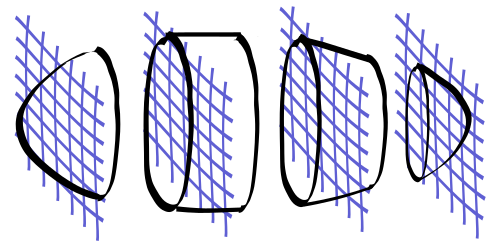
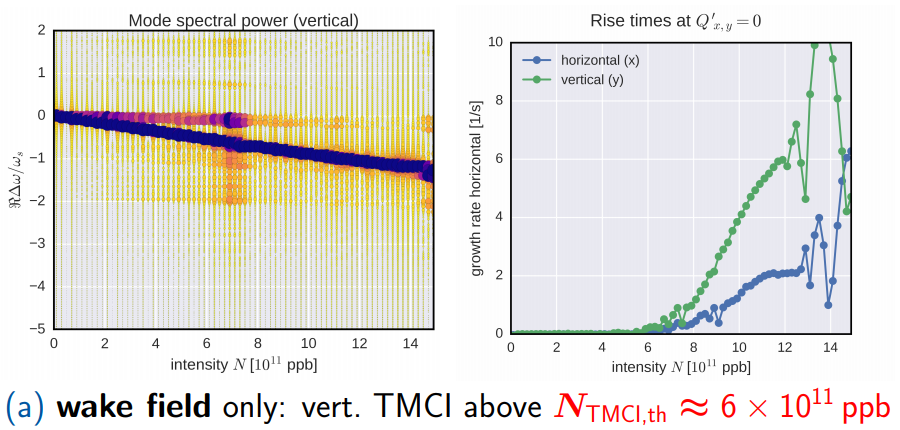
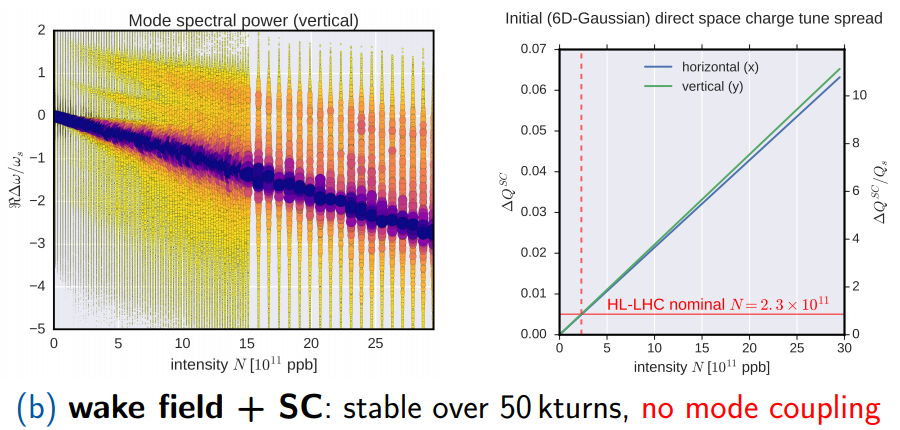
3. SixTrackLib: symplectic non-linear 6D tracking¶
The SixTrackLib library¶
GPU-enabled C templated code with Python API for simulating single-particle beam dynamics: github repo $\nearrow$
$\implies$ advanced non-linear thin-lens tracking, no further approximations
$\implies$ approximative / simplified models for collective effect kicks:
- fixed frozen space charge
- 4D and 6D beam-beam
Background of SixTrackLib¶
- origin:
Fortran77/90codeSixTrack$\nearrow$:- numerically portable across OS and architectures
- used via volunteer computing project LHC@Home $\nearrow$ with $>200$k registered users and $>20$k simultaneously available CPU cores
- modernised
SixTrackLibwritten from scratch by R. de Maria and M. Schwinzerl- standalone library
- in future to be integrated into
SixTrackas new core - supports GPUs via
openCLandCUDA
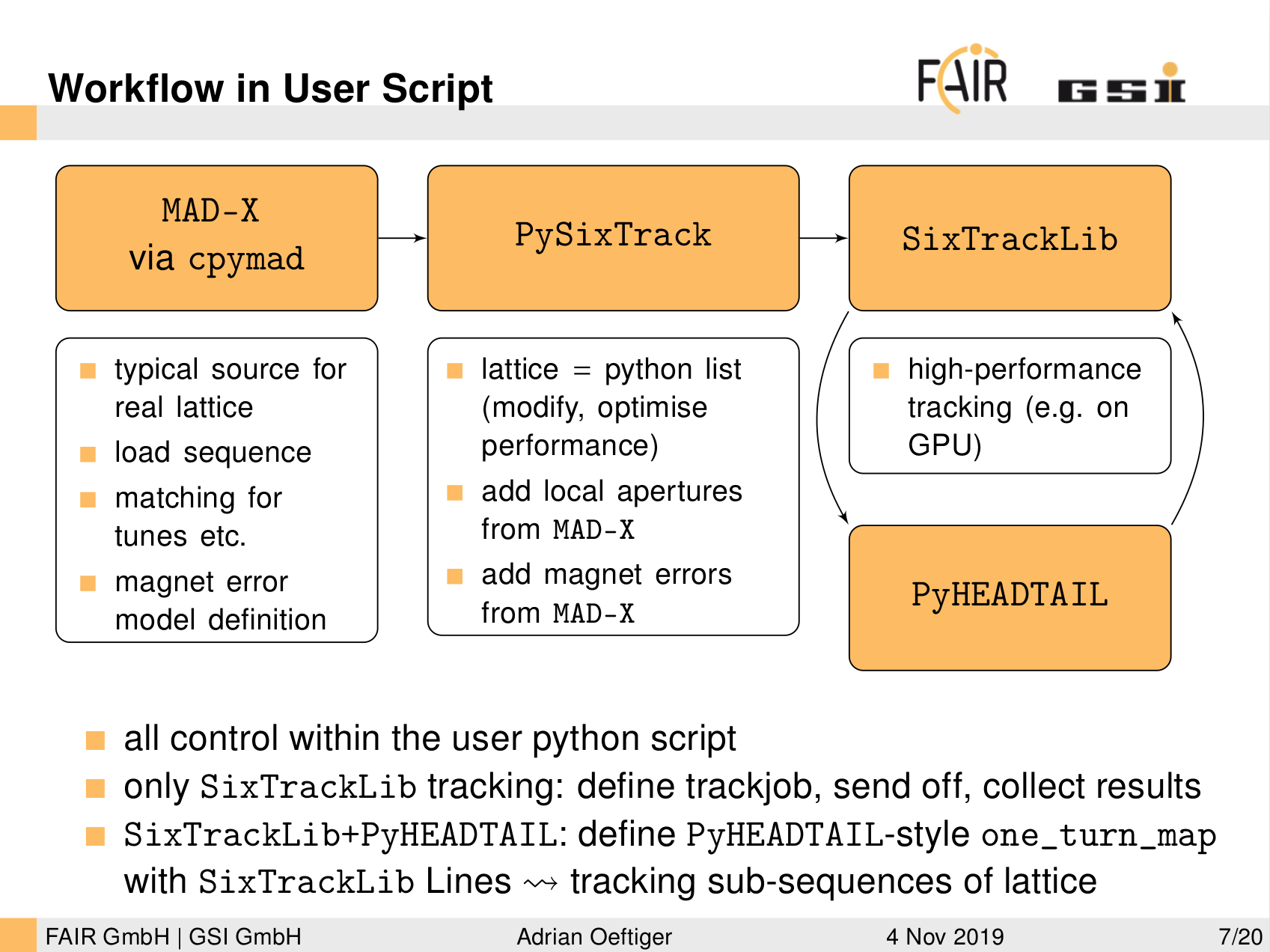
import pysixtrack
import sixtracklib as stl
from cpymad.madx import Madx
MAD-X part first¶
madx = Madx()
madx.options.echo = False
madx.options.warn = False
madx.options.info = False
++++++++++++++++++++++++++++++++++++++++++++ + MAD-X 5.06.00 (64 bit, Linux) + + Support: mad@cern.ch, http://cern.ch/mad + + Release date: 2020.08.13 + + Execution date: 2020.09.03 14:30:51 + ++++++++++++++++++++++++++++++++++++++++++++
Define SIS100 lattice in MAD-X:
madx.call('./SIS100.seq')
Define SIS100 U${}^{28+}$ beam in MAD-X:
from sixtracklib_setup import *
print ('mass = {:d}amu, charge = {:d}e, Ekin = {:.0f}MeV/u'.format(
A, Q, 1e-6 * Ekin_per_nucleon))
mass = 238amu, charge = 28e, Ekin = 200MeV/u
madx.command.beam(particle='ion', mass=A*nmass, charge=Q, energy=Etot);
madx.input('''
kqd := -0.2798446835;
kqf := 0.2809756135;
K1NL_S00QD1D := kqd ;
K1NL_S00QD1F := kqf ;
K1NL_S00QD2F := kqf ;
K1NL_S52QD11 := 1.0139780 * kqd ;
K1NL_S52QD12 := 1.0384325 * kqf ;
''');
madx.use(sequence='sis100ring')
assert madx.command.select(
flag='MAKETHIN',
class_='QUADRUPOLE',
slice_='9',
)
assert madx.command.select(
flag='MAKETHIN',
class_='SBEND',
slice_='9',
)
assert madx.command.makethin(
makedipedge=True,
style='teapot',
sequence='SIS100RING',
)
makethin: style chosen : teapot makethin: slicing sequence : sis100ring
Match tunes to $Q_x=18.84$, $Q_y=18.73$:
madx.use(sequence='sis100ring')
madx.input('''
match, sequence=SIS100RING;
global, sequence=SIS100RING, q1=18.84, q2=18.73;
vary, name=kqf, step=0.00001;
vary, name=kqd, step=0.00001;
lmdif, calls=500, tolerance=1.0e-10;
endmatch;
''');
START MATCHING number of sequences: 1 sequence name: sis100ring number of variables: 2 user given constraints: 2 total constraints: 2 START LMDIF: Initial Penalty Function = 0.11937828E-03 call: 4 Penalty function = 0.20839228E-12 ++++++++++ LMDIF ended: converged successfully call: 4 Penalty function = 0.20839228E-12 MATCH SUMMARY Node_Name Constraint Type Target Value Final Value Penalty -------------------------------------------------------------------------------------------------- Global constraint: q1 4 1.88400000E+01 1.88400000E+01 1.18091011E-13 Global constraint: q2 4 1.87300000E+01 1.87300000E+01 9.03012738E-14 Final Penalty Function = 2.08392285e-13 Variable Final Value Initial Value Lower Limit Upper Limit -------------------------------------------------------------------------------- kqf 2.80985e-01 2.80976e-01 -1.00000e+20 1.00000e+20 kqd -2.79854e-01 -2.79845e-01 -1.00000e+20 1.00000e+20 END MATCH SUMMARY VARIABLE "TAR" SET TO 2.08392285e-13
twiss = madx.twiss();
print ('\nQ1 = {:.2f} and Q2 = {:.2f}'.format(
twiss.summary['q1'], twiss.summary['q2']))
enter Twiss module
iteration: 1 error: 0.000000E+00 deltap: 0.000000E+00
orbit: 0.000000E+00 0.000000E+00 0.000000E+00 0.000000E+00 0.000000E+00 0.000000E+00
++++++ table: summ
length orbit5 alfa gammatr
1083.6 -0 0.00421942094 15.39478305
q1 dq1 betxmax dxmax
18.84000003 -39.80862552 19.95869544 3.138851059
dxrms xcomax xcorms q2
1.400134289 0 0 18.72999997
dq2 betymax dymax dyrms
-39.71522141 21.30590028 0 0
ycomax ycorms deltap synch_1
0 0 0 0
synch_2 synch_3 synch_4 synch_5
0 0 0 0
synch_6 synch_8 nflips
0 0 0
Q1 = 18.84 and Q2 = 18.73
Now transfer SIS100 lattice to PySixTrack¶
pysixtrack_elements = pysixtrack.Line.from_madx_sequence(
madx.sequence.sis100ring,
exact_drift=True, install_apertures=False,
)
pysixtrack_elements.elements is a python list, we can play with it...
Finally go to SixTrackLib¶
Transfer lattice from PySixTrack:
elements = stl.Elements.from_line(pysixtrack_elements)
nturns = 2**16
elements.BeamMonitor(num_stores=nturns);
And define particle set:
npart = 1
particles = stl.Particles.from_ref(npart, p0c=p0c)
particles.x += 1e-6
particles.y += 1e-6
The trackjob will define the simulation kernel for us:
job = stl.TrackJob(elements, particles, device=None)
$\leadsto$ note the device argument:
this can be 'opencl:0.0' for openCL parallelisation, e.g. for multi-core CPU or GPU!
Let's track to confirm the tunes from MAD-X:¶
job.track_until(nturns)
job.collect()
Evaluation:¶
rec_x = job.output.particles[0].x
rec_y = job.output.particles[0].y
plt.plot(rec_x[:128])
plt.plot(rec_y[:128])
[<matplotlib.lines.Line2D at 0x7f6e2c626f90>]
from sixtracklib_setup import plot_tunes_from_stl_results
plot_tunes_from_stl_results(twiss, job)
$\implies$ tunes are on top of MAD-X, perfect!
4. Space Charge & Resonances and 2nd Order Coherent Instabilities¶
SixTrackLib provides extremely fast simulations!
Including in the SIS100 model
- full lattice (from gitlab repo $\nearrow$)
- non-linear, frozen 3D space charge
- field error models until 7th order for dipole and quadrupole magnets
$~\longrightarrow~$ scan 2D tune diagrams, $\approx 2$min per simulation for 20'000 turns
(on virgo.hpc cluster: 64 CPU cores or NVIDIA V100 GPU)
Non-linear magnet resonances + space charge¶
$~\Longrightarrow~$ study space charge limit in SIS100 for heavy-ion cycles:
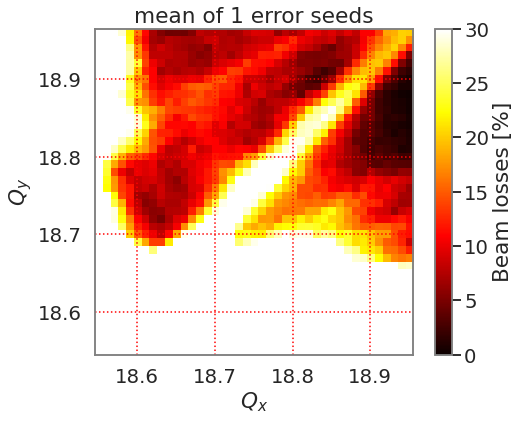 beam loss tune diagram for SIS100
beam loss tune diagram for SIS100
Mitigation techniques¶
- correcting beta-beat
- double harmonic RF for bunch flattening
- electron lenses (to be studied)
Mitigation 1: Correcting Beta-beat¶
No gradient errors in the quadrupole magnets (but all other non-linear field errors):
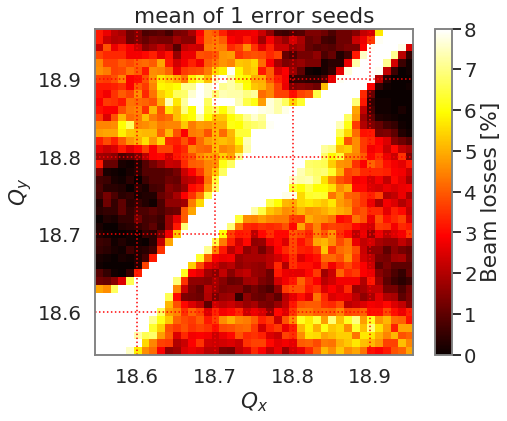 beam loss tune diagram for SIS100
beam loss tune diagram for SIS100
Mitigation 2: Double Harmonic RF¶
Double harmonic $\implies$ flattened bunch profile $\implies$ weaker space charge $\implies$ more space in tune diagram
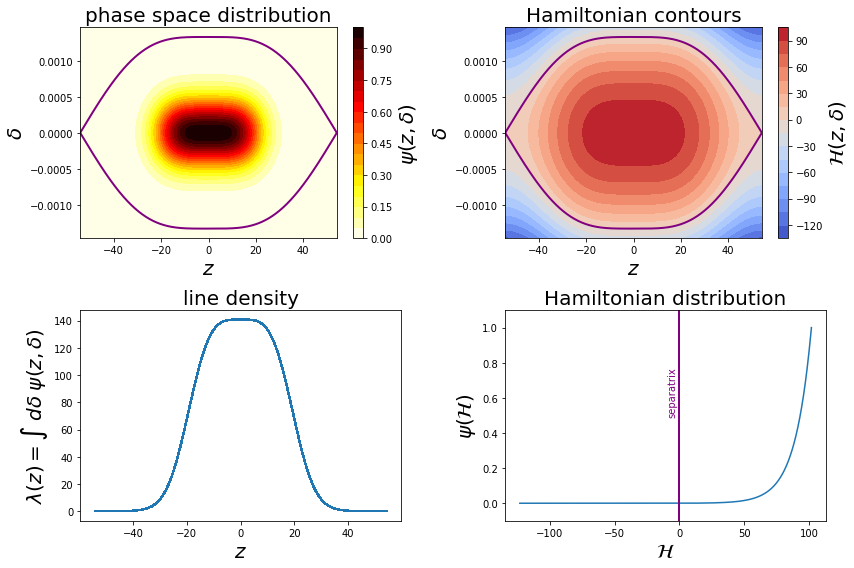
Results:¶
 single harmonic
single harmonic
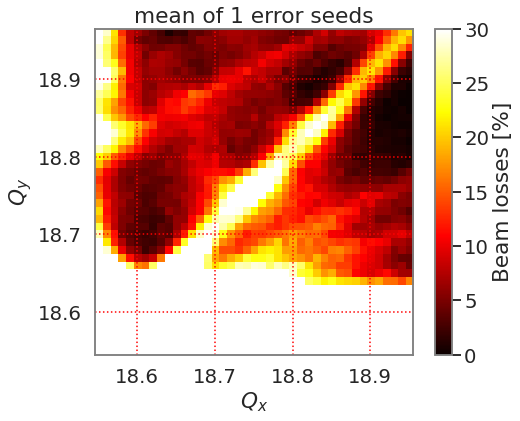 double harmonic
double harmonic
Compare space charge resonance behaviour¶
With the new merger SixHead $=$ SixTrackLib + PyHEADTAIL on the GPU:
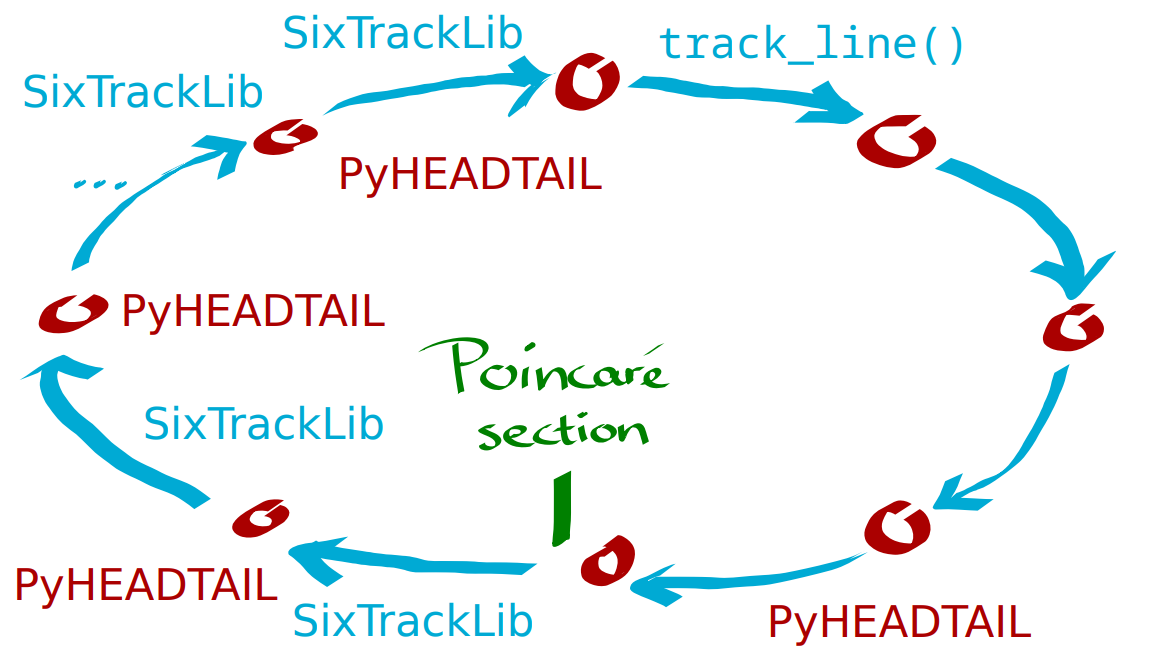 Alternating SixTrackLib tracking and PyHEADTAIL kicking
Alternating SixTrackLib tracking and PyHEADTAIL kicking
Approach:¶
for i in range(n_turns):
# SixTrackLib:
pyht_to_stl()
trackjob.track_until(i)
stl_to_pyht()
# PyHEADTAIL
spacecharge.track(pyht_beam)
$\implies$ compare frozen space charge models with self-consistent 3D particle-in-cell space charge:
 1D tune scan across resonance
1D tune scan across resonance
The $90^\circ$ stop-band¶
Investigating 90deg stop-band with SixHead:
- full 3D selfconsistent study, including synchrotron motion
- characterise higher-order coherent instabilities in synchrotrons
- 10'000 turns on GPU with 4 million macro-particles in $<4$h
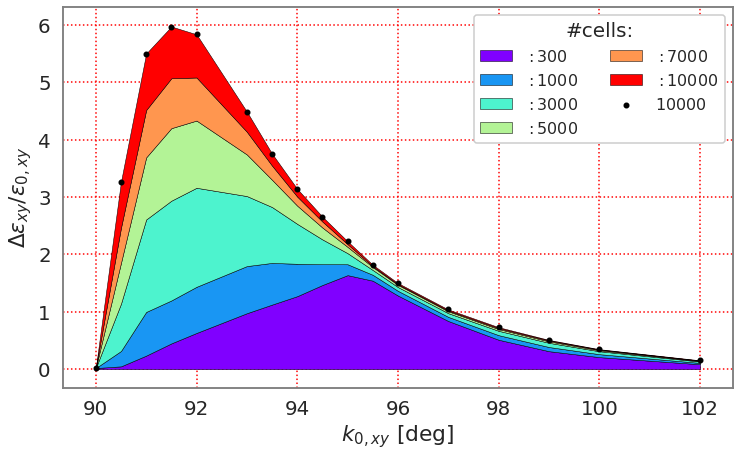 1D tune scan across resonance for 300x slower $Q_s$ than $Q_{x,y}$
1D tune scan across resonance for 300x slower $Q_s$ than $Q_{x,y}$
... so long and thanks for all the fish ...¶
Summary¶
New suite SixHead consisting of:
- symplectic 6D non-linear tracking with
SixTrackLib - collective beam dynamics with
PyHEADTAIL(wakefields, space charge, feedbacks, ...)
is parallelised on:
- multi-core CPU (tracking)
- GPU
and renders possible:
- accurate, fast and flexible simulation studies for SIS18 and SIS100 for high-intensity operation

